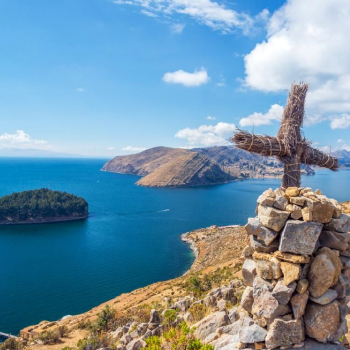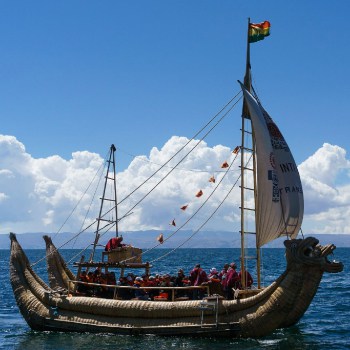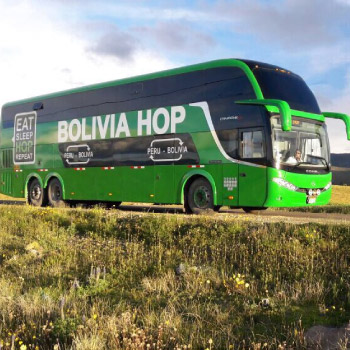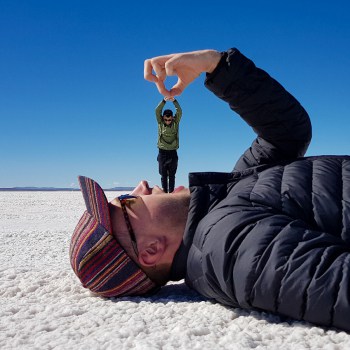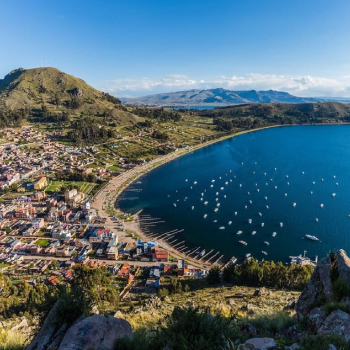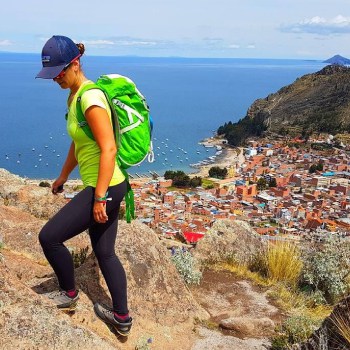Founded by the Spanish in the 16th century, Sucre has been designated a UNESCO world heritage site to protect its many pristine and historically significant buildings. From the charming colonial architecture and immaculately manicured parks to the pleasant year-round weather and unique cultural sites, Sucre is the ideal spot for leisurely exploration. Exuding old-world charm and filled with languid pursuits, most days you will find children chasing pigeons in the plaza, couples enjoying an ice-cream in the sun and old friends catching up in one of the many cozy cafes.
Largely untouched by tourism, the youthful city is a goldmine of unexplored treasures and cultural activity. It’s also one of the cheapest and safest cities in South America, making it the perfect place to visit or live.
Top Things to See and Do in Sucre
Where to Eat & Drink in Sucre
By plane
Located in El Alto, La Paz's international airport is the highest airport in the world at 4,058 m (13,313 ft). The distance between El Alto Airport and the centre of La Paz is around 20 kilometres with an estimated travel time of around 30 minutes. Be aware that during peak hours busses fill up fast, so factor in plenty of time in order to secure a seat.The price of a taxi to and from El Alto airport is Bs 70 ($10 US). Minibuses leave every 5 minutes from Plaza Isabel de Católica and pass by Plaza San Francisco. The cost is around Bs 4 ($0.60 US per person) and busses run daily from 6.15am to 9pm.
By bus
Traveling by bus tends to be the most common way all types of travelers get into La Paz, as they either start further up north or south in South America until they make their way into La Paz. Buses are the cheaper and usually, a more comfortable option, while also getting the chance to enjoy the different sceneries throughout the trip.
For those in Peru coming from Lima or Cusco to La Paz, we strongly recommend Bolivia Hop. They are hop-on, hop-off bus service offering a flexible bus pass (50+ options from long distance to short day trips), in which you can stay however long you want in any of the destinations, letting you enjoy travel at your own pace. Apart from this, there’s onboard bilingual assistance on all their busses, as well as discounts on accommodation. But the biggest advantage of traveling with Bolivia Hop with have to be the border-crossing assistance provided by the onboard guides, who will give you the necessary paperwork and instructions, all while making sure you don't get scammed or lost throughout the process. If you want to learn more about them, click here
For those coming from any of the other bordering countries, there are many options to choose from. But as with most things in life, you get what you pay for. We recommend to fully research the companies, read reviews, blog posts and/or contact the company if necessary!
The following links provide information on how to travel between La Paz and other popular destinations in Bolivia:
Where to Stay in Sucre
By plane
Located in El Alto, La Paz's international airport is the highest airport in the world at 4,058 m (13,313 ft). The distance between El Alto Airport and the centre of La Paz is around 20 kilometres with an estimated travel time of around 30 minutes. Be aware that during peak hours busses fill up fast, so factor in plenty of time in order to secure a seat.The price of a taxi to and from El Alto airport is Bs 70 ($10 US). Minibuses leave every 5 minutes from Plaza Isabel de Católica and pass by Plaza San Francisco. The cost is around Bs 4 ($0.60 US per person) and busses run daily from 6.15am to 9pm.
By bus
Traveling by bus tends to be the most common way all types of travelers get into La Paz, as they either start further up north or south in South America until they make their way into La Paz. Buses are the cheaper and usually, a more comfortable option, while also getting the chance to enjoy the different sceneries throughout the trip.
For those in Peru coming from Lima or Cusco to La Paz, we strongly recommend Bolivia Hop. They are hop-on, hop-off bus service offering a flexible bus pass (50+ options from long distance to short day trips), in which you can stay however long you want in any of the destinations, letting you enjoy travel at your own pace. Apart from this, there’s onboard bilingual assistance on all their busses, as well as discounts on accommodation. But the biggest advantage of traveling with Bolivia Hop with have to be the border-crossing assistance provided by the onboard guides, who will give you the necessary paperwork and instructions, all while making sure you don't get scammed or lost throughout the process. If you want to learn more about them, click here
For those coming from any of the other bordering countries, there are many options to choose from. But as with most things in life, you get what you pay for. We recommend to fully research the companies, read reviews, blog posts and/or contact the company if necessary!
The following links provide information on how to travel between La Paz and other popular destinations in Bolivia:
Shopping in Sucre
By plane
Located in El Alto, La Paz's international airport is the highest airport in the world at 4,058 m (13,313 ft). The distance between El Alto Airport and the centre of La Paz is around 20 kilometres with an estimated travel time of around 30 minutes. Be aware that during peak hours busses fill up fast, so factor in plenty of time in order to secure a seat.The price of a taxi to and from El Alto airport is Bs 70 ($10 US). Minibuses leave every 5 minutes from Plaza Isabel de Católica and pass by Plaza San Francisco. The cost is around Bs 4 ($0.60 US per person) and busses run daily from 6.15am to 9pm.
By bus
Traveling by bus tends to be the most common way all types of travelers get into La Paz, as they either start further up north or south in South America until they make their way into La Paz. Buses are the cheaper and usually, a more comfortable option, while also getting the chance to enjoy the different sceneries throughout the trip.
For those in Peru coming from Lima or Cusco to La Paz, we strongly recommend Bolivia Hop. They are hop-on, hop-off bus service offering a flexible bus pass (50+ options from long distance to short day trips), in which you can stay however long you want in any of the destinations, letting you enjoy travel at your own pace. Apart from this, there’s onboard bilingual assistance on all their busses, as well as discounts on accommodation. But the biggest advantage of traveling with Bolivia Hop with have to be the border-crossing assistance provided by the onboard guides, who will give you the necessary paperwork and instructions, all while making sure you don't get scammed or lost throughout the process. If you want to learn more about them, click here
For those coming from any of the other bordering countries, there are many options to choose from. But as with most things in life, you get what you pay for. We recommend to fully research the companies, read reviews, blog posts and/or contact the company if necessary!
The following links provide information on how to travel between La Paz and other popular destinations in Bolivia:
Events & Festivals in Sucre
Getting To, From & Around Sucre
By plane
Located in El Alto, La Paz's international airport is the highest airport in the world at 4,058 m (13,313 ft). The distance between El Alto Airport and the centre of La Paz is around 20 kilometres with an estimated travel time of around 30 minutes. Be aware that during peak hours busses fill up fast, so factor in plenty of time in order to secure a seat.The price of a taxi to and from El Alto airport is Bs 70 ($10 US). Minibuses leave every 5 minutes from Plaza Isabel de Católica and pass by Plaza San Francisco. The cost is around Bs 4 ($0.60 US per person) and busses run daily from 6.15am to 9pm.
By bus
Traveling by bus tends to be the most common way all types of travelers get into La Paz, as they either start further up north or south in South America until they make their way into La Paz. Buses are the cheaper and usually, a more comfortable option, while also getting the chance to enjoy the different sceneries throughout the trip.
For those in Peru coming from Lima or Cusco to La Paz, we strongly recommend Bolivia Hop. They are hop-on, hop-off bus service offering a flexible bus pass (50+ options from long distance to short day trips), in which you can stay however long you want in any of the destinations, letting you enjoy travel at your own pace. Apart from this, there’s onboard bilingual assistance on all their busses, as well as discounts on accommodation. But the biggest advantage of traveling with Bolivia Hop with have to be the border-crossing assistance provided by the onboard guides, who will give you the necessary paperwork and instructions, all while making sure you don't get scammed or lost throughout the process. If you want to learn more about them, click here
For those coming from any of the other bordering countries, there are many options to choose from. But as with most things in life, you get what you pay for. We recommend to fully research the companies, read reviews, blog posts and/or contact the company if necessary!
The following links provide information on how to travel between La Paz and other popular destinations in Bolivia:
Finding Wifi in Sucre
By plane
Located in El Alto, La Paz's international airport is the highest airport in the world at 4,058 m (13,313 ft). The distance between El Alto Airport and the centre of La Paz is around 20 kilometres with an estimated travel time of around 30 minutes. Be aware that during peak hours busses fill up fast, so factor in plenty of time in order to secure a seat.The price of a taxi to and from El Alto airport is Bs 70 ($10 US). Minibuses leave every 5 minutes from Plaza Isabel de Católica and pass by Plaza San Francisco. The cost is around Bs 4 ($0.60 US per person) and busses run daily from 6.15am to 9pm.
By bus
Traveling by bus tends to be the most common way all types of travelers get into La Paz, as they either start further up north or south in South America until they make their way into La Paz. Buses are the cheaper and usually, a more comfortable option, while also getting the chance to enjoy the different sceneries throughout the trip.
For those in Peru coming from Lima or Cusco to La Paz, we strongly recommend Bolivia Hop. They are hop-on, hop-off bus service offering a flexible bus pass (50+ options from long distance to short day trips), in which you can stay however long you want in any of the destinations, letting you enjoy travel at your own pace. Apart from this, there’s onboard bilingual assistance on all their busses, as well as discounts on accommodation. But the biggest advantage of traveling with Bolivia Hop with have to be the border-crossing assistance provided by the onboard guides, who will give you the necessary paperwork and instructions, all while making sure you don't get scammed or lost throughout the process. If you want to learn more about them, click here
For those coming from any of the other bordering countries, there are many options to choose from. But as with most things in life, you get what you pay for. We recommend to fully research the companies, read reviews, blog posts and/or contact the company if necessary!
The following links provide information on how to travel between La Paz and other popular destinations in Bolivia:
Further Reading
By plane
Located in El Alto, La Paz's international airport is the highest airport in the world at 4,058 m (13,313 ft). The distance between El Alto Airport and the centre of La Paz is around 20 kilometres with an estimated travel time of around 30 minutes. Be aware that during peak hours busses fill up fast, so factor in plenty of time in order to secure a seat.The price of a taxi to and from El Alto airport is Bs 70 ($10 US). Minibuses leave every 5 minutes from Plaza Isabel de Católica and pass by Plaza San Francisco. The cost is around Bs 4 ($0.60 US per person) and busses run daily from 6.15am to 9pm.
By bus
Traveling by bus tends to be the most common way all types of travelers get into La Paz, as they either start further up north or south in South America until they make their way into La Paz. Buses are the cheaper and usually, a more comfortable option, while also getting the chance to enjoy the different sceneries throughout the trip.
For those in Peru coming from Lima or Cusco to La Paz, we strongly recommend Bolivia Hop. They are hop-on, hop-off bus service offering a flexible bus pass (50+ options from long distance to short day trips), in which you can stay however long you want in any of the destinations, letting you enjoy travel at your own pace. Apart from this, there’s onboard bilingual assistance on all their busses, as well as discounts on accommodation. But the biggest advantage of traveling with Bolivia Hop with have to be the border-crossing assistance provided by the onboard guides, who will give you the necessary paperwork and instructions, all while making sure you don't get scammed or lost throughout the process. If you want to learn more about them, click here
For those coming from any of the other bordering countries, there are many options to choose from. But as with most things in life, you get what you pay for. We recommend to fully research the companies, read reviews, blog posts and/or contact the company if necessary!
The following links provide information on how to travel between La Paz and other popular destinations in Bolivia:

